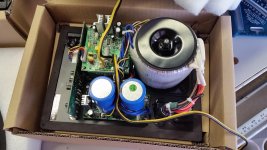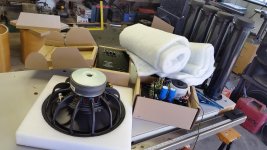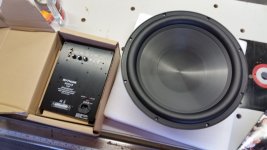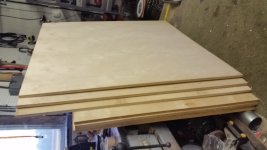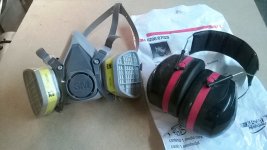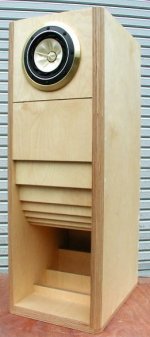@bwaslo,
Had you ever considered experimenting with one of the Analog Devices accelerometer chips?
They are very small/light, flat response to DC using SOI MEMS based sensor instead of piezo like the ACH-01.
This should make it immune to effects of induced strain from less than ideal mounting technique.
Also, according to the spect sheet, sensor and circuitry is fully balanced for immunity from EMI.
I managed to get a sample of the +/-250g chip, but haven't had time to play with it yet.
Had you ever considered experimenting with one of the Analog Devices accelerometer chips?
They are very small/light, flat response to DC using SOI MEMS based sensor instead of piezo like the ACH-01.
This should make it immune to effects of induced strain from less than ideal mounting technique.
Also, according to the spect sheet, sensor and circuitry is fully balanced for immunity from EMI.
I managed to get a sample of the +/-250g chip, but haven't had time to play with it yet.
Attachments
Understood, but you are referring to the MDSP being used inside the loop if I have my hat on correctly.From my experience, 1 - 2ms sounds about right for the standard miniDSP 2x4...it depends on exactly what plugins/filters you are using. I'm guessing a good portion of that time is for the ADC at the input and DAC out the output. bentoronto is right that you will need something faster...I'd suggest at least 100uS if you plan to have more than about 10dB - 15dB of loop gain. I have not had the opportunity to test the HD version of the miniDSP 2x4 yet, so can't comment on it's latency.
I was talking about using it between source and before amp input.
In which case the 2x4 would work in a basic 2.1 or 2.2 system.
Speaking of hats, and NOT having them on correctly:
For a 5.2 (my setup), the 2x4 would be almost useless. I'd need a 2x8 more or less to compensate.
Well, scrap that idea, as big $$ is involved. (oh bother😱)
On the upside, I just re-read the Analog Servo thread again, and have a much better grasp on everything now.
Side note: Thanks guys, for sharing your knowledge..much appreciated...🙂
Last edited:
The obligatory AVS-style 'show and tell' post here..😎
Afterall, I'm the one who chose to buy them.
Hey, if they prove to be sub-par, I do have a buyer for the kits...same price I paid. 😉
Afterall, I'm the one who chose to buy them.
Hey, if they prove to be sub-par, I do have a buyer for the kits...same price I paid. 😉
Attachments
Hi,
@bolserst
I´ve got some samples of the +-70g types also, which are more suited to most drivers.
+-250g is rather the range for one of those extreme longthrow beasts like TC Sounds Ultra5400.
I remember from a much earlier thread that someone (SY? or TranquilityBass??) explained that the ADXL chips are rather too noisy due to all the electronics involved .. but then ... I am tempted to perform those test in future 😉
I suspended further tests with those devices since as You can read at JoshRicci´s site that a well executed driver in a suitable cabinet is in no way inferior than a MFDed one.
Compare for example the Velodyne 18 mentioned above with the TCSound Ultra5400 (in DIY-CB-casing), where the TCSound outperforms the Velo in almost every respect ... more SPL, less THD at lowest frequencies, better impulse response.
The Velo´s THD falls below the TC´s at freqs >40Hz only, but at ~6dB to 8dB less SPL than the TC .... so in fact probabely not better at all at the same SPL.
So MFB seems rather suited (or commercially sensitive) to improve the behaviour of cheap or mediocre drivers. 😉
jauu
Calvin
@bolserst
I´ve got some samples of the +-70g types also, which are more suited to most drivers.
+-250g is rather the range for one of those extreme longthrow beasts like TC Sounds Ultra5400.
I remember from a much earlier thread that someone (SY? or TranquilityBass??) explained that the ADXL chips are rather too noisy due to all the electronics involved .. but then ... I am tempted to perform those test in future 😉
I suspended further tests with those devices since as You can read at JoshRicci´s site that a well executed driver in a suitable cabinet is in no way inferior than a MFDed one.
Compare for example the Velodyne 18 mentioned above with the TCSound Ultra5400 (in DIY-CB-casing), where the TCSound outperforms the Velo in almost every respect ... more SPL, less THD at lowest frequencies, better impulse response.
The Velo´s THD falls below the TC´s at freqs >40Hz only, but at ~6dB to 8dB less SPL than the TC .... so in fact probabely not better at all at the same SPL.
So MFB seems rather suited (or commercially sensitive) to improve the behaviour of cheap or mediocre drivers. 😉
jauu
Calvin
The legitimate comparison would be between the TC..5400 with MF and then without MF, not between apples and oranges.Compare for example the Velodyne 18 mentioned above with the TCSound Ultra5400 (in DIY-CB-casing), where the TCSound outperforms the Velo in almost every respect ... more SPL, less THD at lowest frequencies, better impulse response.
B.
Hi,
I legitimately compare one black box outcome to a second black box outcome. 😉
One with an 18" driver plus mfb and the second with a obviously superior 18" driver.
And the result simply is that the better driver box is superior to the mfb box.
As others also pointed out before this looks like the proof to me that using a superior driver (or maybe also multiple drivers) can result in at least similar good thd figures ... or the other way round ... that mfb isn't a guarantuee for best results, or that its worth the effort other than a academic learning lesson.
jauu
Calvin
I legitimately compare one black box outcome to a second black box outcome. 😉
One with an 18" driver plus mfb and the second with a obviously superior 18" driver.
And the result simply is that the better driver box is superior to the mfb box.
As others also pointed out before this looks like the proof to me that using a superior driver (or maybe also multiple drivers) can result in at least similar good thd figures ... or the other way round ... that mfb isn't a guarantuee for best results, or that its worth the effort other than a academic learning lesson.
jauu
Calvin
...can result in at least similar good thd figures ... or the other way round ... that mfb isn't a guarantuee for best results, or that its worth the effort other than a academic learning lesson.
You have established that a very expensive mechanical device can have THD performance comparable to one of the MF speakers on the market. But the commercialized systems have low feedback factors to avoid instability when sold to unsophisticated users.
Nobody here is interested in "academic learning lesson
Let's be clear, MF isn't a passing fad or audio marketing gimmick. Anybody with the least knowledge of audio engineering history knows that enclosing the system* in feedback is a necessary direction for progress.
Yes, some folks think speakers today are really swell. But it is irritating to hear that trope over and over as if it was stupid to pursue this line of R&D as wreckingball has. A lot of the posts from these critics are totally lacking in anything constructive or even analytically helpful.
Ben
*all systems whether mechanical, electrical, or human.
Last edited:
As with other threads on servo/MF, we have another who says it may not be worth it to pursue, that's fine. Everyone has to calculate/balance their time and money, and decide how much they can spend either of them.
As for me, at this point, I have a bit more money than time to spend, so I chose the route I did... Will the results be worth it? We'll see. If not, I'll need to do a ton more research, and that means a lot more time..😱
There is only one build thread that I know of using Rythmik's ported design on all of the interwebz. Interestingly enough, he transferred from sealed to ported for more SPL from one enclosure utilizing the same kit.
He also states that he gave up little to no sound quality in doing so, even though he was worried that ported would sound inferior.
Google translate does a decent enough job that I can follow along with the build and measurements, with the exception of a few words, particularly the word "cash", I sure wish I knew enough norwegian to understand..lol..
Oh, and the pics do help out quite a bit as well..🙂
Thread is here: DIY Rythmik FV15. Ferdig!
Fortunately, also helping in the money column, I just aquired all this BB. 3 sheets of finish-grade 5'x5', and 4 sheets regular 4'x4' (pic)
As for me, at this point, I have a bit more money than time to spend, so I chose the route I did... Will the results be worth it? We'll see. If not, I'll need to do a ton more research, and that means a lot more time..😱
There is only one build thread that I know of using Rythmik's ported design on all of the interwebz. Interestingly enough, he transferred from sealed to ported for more SPL from one enclosure utilizing the same kit.
He also states that he gave up little to no sound quality in doing so, even though he was worried that ported would sound inferior.
Google translate does a decent enough job that I can follow along with the build and measurements, with the exception of a few words, particularly the word "cash", I sure wish I knew enough norwegian to understand..lol..
Oh, and the pics do help out quite a bit as well..🙂
Thread is here: DIY Rythmik FV15. Ferdig!
Fortunately, also helping in the money column, I just aquired all this BB. 3 sheets of finish-grade 5'x5', and 4 sheets regular 4'x4' (pic)
Attachments
As Data-Bass says, he didn't think MF was for ported boxes*, but what the heck.As with other threads on servo/MF, we have another who says it may not be worth it to pursue, that's fine
Likely you still have no small amount of DIY fun ahead as your project evolves. Not likely to be just plug-and-play.
Ben
*except for mic sensors and insanely complicated DSP EQ, that's theory; the sound output from vented boxes in the region most important for MF around resonance does not correspond to the cone motion. Anybody think otherwise?
Hi wreckingball,
Good to see your progress.
Here are two tools you hopefully already have in your tool inventory: a decent gas mask and ear muffs. You probably know that the dust and noise from modern woodworking tools doesn't help one's health. I consider the 6200-3M half face respirator w/ the 6003 organic vapor gas cartridge a very good starting point, and at least 30dB hearing protection is a must.
Regards,
Good to see your progress.
Here are two tools you hopefully already have in your tool inventory: a decent gas mask and ear muffs. You probably know that the dust and noise from modern woodworking tools doesn't help one's health. I consider the 6200-3M half face respirator w/ the 6003 organic vapor gas cartridge a very good starting point, and at least 30dB hearing protection is a must.
Regards,
Attachments
Hi wreckingball,
Nice thread you are linking to in Post #49. From the pictures it looks like there may be some problems with the bracing? The interior is divided into three chambers, w/ the woofer in chamber #1, and the port entry in chamber #3, I think there should be more holes in the dividers/braces? Did you get the sealed or the vented subwoofer kit from Rythmik, or can they be used both ways?
Regards,
Nice thread you are linking to in Post #49. From the pictures it looks like there may be some problems with the bracing? The interior is divided into three chambers, w/ the woofer in chamber #1, and the port entry in chamber #3, I think there should be more holes in the dividers/braces? Did you get the sealed or the vented subwoofer kit from Rythmik, or can they be used both ways?
Regards,
Well, the thread if from 2011, and at that time the sealed (F15) kit was interchangeable into vented. I hear they make a small change between the two now.Hi wreckingball,
Nice thread you are linking to in Post #49. From the pictures it looks like there may be some problems with the bracing? The interior is divided into three chambers, w/ the woofer in chamber #1, and the port entry in chamber #3, I think there should be more holes in the dividers/braces? Did you get the sealed or the vented subwoofer kit from Rythmik, or can they be used both ways?
Regards,
That thread is just a rough guideline, as he changed both dia. and L of the ports, and as you said, the bracing.
I have that FV15HP kit's 'little brother' (His= 600w&15xx driver, mine 400w amp&1501 driver).
I agree with you about more holes in bracing, I think he did his that way because only using 12mm thickness for them.
Mine are going to be primarily 1.25" doweling, of which I have a ton leftover from my old job.
Would you be interested in bouncing some construction notes around (no pressure, respond when you like) via this thread or PM?
Reason I ask is I am not following the general shape of the FVX15 box, and those are the plans Rythmik sent me that correspond with my kit(s).
Cheers
Last edited:
I'd allow for the possibility of sealing the ports or aperiodic (resistive vent) or leaky box (which is close to MF assumptions).
Then, you'd get some percussion music such as Paul Lansky's Threads (performed by So Percussion)*. Great music and should show how much "group delay" remains lurking with vent-MF and if you can tolerate it. That will help clarify whether you want vents or sealed. Likely you can record speaker playing clicks and audition them in close time comparison.
+1 about tb46 safety ideas. I saw outdoors.
Ben
*percussion transients are spectacular with electrostats
Then, you'd get some percussion music such as Paul Lansky's Threads (performed by So Percussion)*. Great music and should show how much "group delay" remains lurking with vent-MF and if you can tolerate it. That will help clarify whether you want vents or sealed. Likely you can record speaker playing clicks and audition them in close time comparison.
+1 about tb46 safety ideas. I saw outdoors.
Ben
*percussion transients are spectacular with electrostats
Last edited:
@ Ben
Already part of the plan, and they included tight-fitting foam plugs that go about 5" into the ports.
But since you bring it up, let me run this by you and everyone.
On the site they say using the plugs on both ports results in aperiodic loading/response.
But what if I used something that could completely seal the ports? Would it then act just like a sealed box, or would results be undesirable?
A simple pluming product like this, (hey, if it holds water ...then ?)
The ID of the ports are 3.5" this says max of 3.75", and min of 3.23".
Could hide nicely under the grill or be painted I suppose:
https://www.grainger.com/product/CH...g-1VNG2?opr=APPD&pbi=3EJN8&analytics=altItems
I'd just have to be careful not to over-tighten..😱
Already part of the plan, and they included tight-fitting foam plugs that go about 5" into the ports.
But since you bring it up, let me run this by you and everyone.
On the site they say using the plugs on both ports results in aperiodic loading/response.
But what if I used something that could completely seal the ports? Would it then act just like a sealed box, or would results be undesirable?
A simple pluming product like this, (hey, if it holds water ...then ?)
The ID of the ports are 3.5" this says max of 3.75", and min of 3.23".
Could hide nicely under the grill or be painted I suppose:
https://www.grainger.com/product/CH...g-1VNG2?opr=APPD&pbi=3EJN8&analytics=altItems
I'd just have to be careful not to over-tighten..😱
Hi wreckingball,
Post #53: "... interested in bouncing some construction notes around..."
Sure, sounds like fun. Just shoot, here or PM is fine. 🙂
It's been quite a while that I looked at Rythmik's website, but I remember that there was a difference in the feedback electronics between close and vented.
As to safety tips: as I'm always wearing some form of glasses I tend to forget safety glasses.
Regards,
Post #53: "... interested in bouncing some construction notes around..."
Sure, sounds like fun. Just shoot, here or PM is fine. 🙂
It's been quite a while that I looked at Rythmik's website, but I remember that there was a difference in the feedback electronics between close and vented.
As to safety tips: as I'm always wearing some form of glasses I tend to forget safety glasses.
Regards,
@ Oliver
OK, great..🙂
Yes, I know that the boards in the amps have differences now, I seem to remember Brian letting someone know what needed to change to go from sealed to vented.
I wear glasses as well, and because they're required for work they are safety glass.
First construction question: I've always used veneer or several coats of primer/paint on my subs, so butt joints, screws etc. were always used.
These however, are going to be all finish-grade Baltic Birch, with the exception of the dowel braces.
Do you think that mitered corners is a good idea? Difficulty level?
I have a TS with a t-square fence system, so the actual cutting should be relatively straight forward, but what about (one-man) assembly?
I have a biscuit machine and biscuits, but what about voids due to tolerances? Difficulty using on mitered box?
Also because I'd like the 4 sides to be one continuous piece of BB from top to bottom, I was thinking of placing the back/baffle inside of them, do you foresee any problems?
Linking to a site if you don't feel like typing all that is fine too.
Thanks
OK, great..🙂
Yes, I know that the boards in the amps have differences now, I seem to remember Brian letting someone know what needed to change to go from sealed to vented.
I wear glasses as well, and because they're required for work they are safety glass.
First construction question: I've always used veneer or several coats of primer/paint on my subs, so butt joints, screws etc. were always used.
These however, are going to be all finish-grade Baltic Birch, with the exception of the dowel braces.
Do you think that mitered corners is a good idea? Difficulty level?
I have a TS with a t-square fence system, so the actual cutting should be relatively straight forward, but what about (one-man) assembly?
I have a biscuit machine and biscuits, but what about voids due to tolerances? Difficulty using on mitered box?
Also because I'd like the 4 sides to be one continuous piece of BB from top to bottom, I was thinking of placing the back/baffle inside of them, do you foresee any problems?
Linking to a site if you don't feel like typing all that is fine too.
Thanks
Hi wreckingball,
Some thoughts speaker building and corner joints:
First some links: take a look @ thejessman's facebook page, Triticum Audio:
https://www.facebook.com/search/top/?q=triticum audio
He has a lot of pictures, great speaker building page. Maybe, he'll chime in here? Looks like he has gotten himself some custom edge router bits to cut interlocking mitered corners on a router table, but he uses other methods too.
Also, @ speakerplans.com the Guide:
Speakerplans.com
General:
I believe in reinforcing corners from the inside w/ battens. Can be time consuming, but makes for a sturdy box. Battens can be used to screw in panels, or can be fitted after the corner is build (use glue and air nailer).
I also like to build in layers, e.g.: use an internal particle board wood layer that has all the screw holes, etc. from basic construction, baffle and braces attachment, and then add an exterior veneer plywood. Corners can be finished w/ hardwood inserts.
Glues: I like carpenters glue (e.g.: Titebond Original) for its easy cleanup. Lots of the pros around here swear by PL (polyurethane) glues, they are better @ void filling, and very strong.
You do have a finish air nailer? That's almost a must for one man woodworkers.
Biscuits/Pocket screws: I only use biscuits on butt joints, and have not found voids from using the biscuit cutter to be a problem. If necessary, I like to prefit the biscuits, sand them down a little so that they go together more easily (most of the time I work alone). Use lots of clue in the cuts. Use a pocket hole jig (e.g.: Kreg R3) to attach boards in the middle of other boards (e.g.: interior baffles). Don't know how we ever got along w/o biscuits and pocket screw jigs.
More general:
- I like he look of cleanly cut void-free plywood edges, so I would not eliminate butt joints as an option. Easy to use biscuit joints, clamps, air nailer... That's my preferred way of building boxes. (You also can shave the wood back to the last veneer layer, and use that to cover the end veneer.) A straight bit in a router can be effective in cleaning up a box edge after table sawing (rarely takes more than 1/32nd inch, plan ahead).
- Small boxes (e.g.: your regular 5" + tweet bookshelf) w/ mitered corners should not pose a problem. One way is to lay the 2 sides that build a corner on a flat surface, and apply tape to the outside of the aligned corner pieces, than fold to create the corner. Once happy w/ the fit lay down flat again, apply glue, and fold to 90° (+/- 0°). The angle must be held/clamped until the glue is hard. I have some corner clamps for that purpose, or use a box and clamps. I have done corners up to ~ about 30" that way. I have not used biscuit joints on mitered corners (have to try that one of these days).
Hope this helps,
Regards,
-
Some thoughts speaker building and corner joints:
First some links: take a look @ thejessman's facebook page, Triticum Audio:
https://www.facebook.com/search/top/?q=triticum audio
He has a lot of pictures, great speaker building page. Maybe, he'll chime in here? Looks like he has gotten himself some custom edge router bits to cut interlocking mitered corners on a router table, but he uses other methods too.
Also, @ speakerplans.com the Guide:
Speakerplans.com
General:
I believe in reinforcing corners from the inside w/ battens. Can be time consuming, but makes for a sturdy box. Battens can be used to screw in panels, or can be fitted after the corner is build (use glue and air nailer).
I also like to build in layers, e.g.: use an internal particle board wood layer that has all the screw holes, etc. from basic construction, baffle and braces attachment, and then add an exterior veneer plywood. Corners can be finished w/ hardwood inserts.
Glues: I like carpenters glue (e.g.: Titebond Original) for its easy cleanup. Lots of the pros around here swear by PL (polyurethane) glues, they are better @ void filling, and very strong.
You do have a finish air nailer? That's almost a must for one man woodworkers.
Biscuits/Pocket screws: I only use biscuits on butt joints, and have not found voids from using the biscuit cutter to be a problem. If necessary, I like to prefit the biscuits, sand them down a little so that they go together more easily (most of the time I work alone). Use lots of clue in the cuts. Use a pocket hole jig (e.g.: Kreg R3) to attach boards in the middle of other boards (e.g.: interior baffles). Don't know how we ever got along w/o biscuits and pocket screw jigs.
More general:
- I like he look of cleanly cut void-free plywood edges, so I would not eliminate butt joints as an option. Easy to use biscuit joints, clamps, air nailer... That's my preferred way of building boxes. (You also can shave the wood back to the last veneer layer, and use that to cover the end veneer.) A straight bit in a router can be effective in cleaning up a box edge after table sawing (rarely takes more than 1/32nd inch, plan ahead).
- Small boxes (e.g.: your regular 5" + tweet bookshelf) w/ mitered corners should not pose a problem. One way is to lay the 2 sides that build a corner on a flat surface, and apply tape to the outside of the aligned corner pieces, than fold to create the corner. Once happy w/ the fit lay down flat again, apply glue, and fold to 90° (+/- 0°). The angle must be held/clamped until the glue is hard. I have some corner clamps for that purpose, or use a box and clamps. I have done corners up to ~ about 30" that way. I have not used biscuit joints on mitered corners (have to try that one of these days).
Hope this helps,
Regards,
-
Attachments
Last edited:
Thanks Oliver, for the links and all of your notes, much appreciated.
I got to thinking about roundovers applied to the void-free birch I'm using..
I think I am going to go the rabbet route, then roundover 3/8" (half thickness) for a nice looking edge to the boxes, should not be hard with the equipment I have..
Unfortunately, I do not have a working compressor for my nail-gun, but I think if I cut the back, braces, and double baffle first, then glue them up sequentially, I'll be OK.
A pic of what I have in mind is on the lower center of this picture, minus the modifications up top:

The table saw and related, fire up tomorrow!
I got to thinking about roundovers applied to the void-free birch I'm using..
I think I am going to go the rabbet route, then roundover 3/8" (half thickness) for a nice looking edge to the boxes, should not be hard with the equipment I have..
Unfortunately, I do not have a working compressor for my nail-gun, but I think if I cut the back, braces, and double baffle first, then glue them up sequentially, I'll be OK.
A pic of what I have in mind is on the lower center of this picture, minus the modifications up top:

The table saw and related, fire up tomorrow!
This was covered multiple times in the other MFB thread.As Data-Bass says, he didn't think MF was for ported boxes…except for mic sensors and insanely complicated DSP EQ, that's theory; the sound output from vented boxes in the region most important for MF around resonance does not correspond to the cone motion. Anybody think otherwise?
You are correct that MFB in the traditional sense (forcing cone motion to match input signal) is not well suited for vented boxes. But, this is not what Rythmik and Ace-Bass are doing. They are using feedback from the woofer to manipulate the T/S parameters to achieve more extended and better damped response for a given woofer and box size. The feedback networks need to be optimized for the desired woofer/box combination. It is not a one-size fits most situation. Perhaps it would be better for you to think of it as an adaptive EQ that is self-correcting for VC temp and T/S parameter drift that just happens to use feedback from the woofer.
- Status
- Not open for further replies.
- Home
- Loudspeakers
- Subwoofers
- DIY servo sub KIT?
